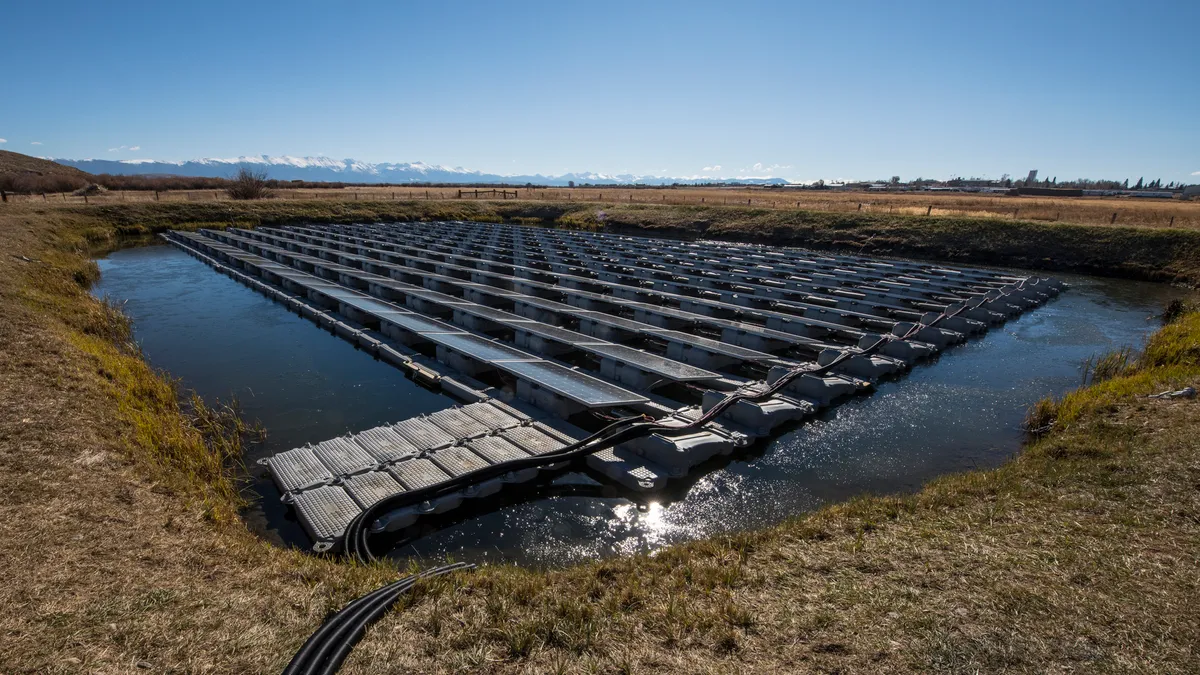Dive Brief:
-
National Renewable Energy Laboratory (NREL) researchers announced last week that the United States has the technical potential to install 2,116 GW of floating photovoltaic (PV) systems in the United States.
-
By the end of 2017, the United States had only seven floating solar projects representing a small fraction of the total 198 MW installed internationally, largely in Japan. The biggest barrier to increasing floating PV development in the nation remains the amount of risk associated with the technology's operation and manufacturing, NREL researchers told Utility Dive.
-
The high-level analysis references the potential benefits and impacts from developing in about 24,400 man-made bodies of water. NREL researchers are pursuing data-collection studies, estimated to begin as soon as spring of 2019, to conduct a more technical analysis of the operational and maintenance costs of a floating solar project in the longer term.
Dive Insight:
As states move to decarbonize the power sector, the nascent technology offers an alternative to expansive, land-based solar arrays.
NREL published the first top-level analysis on the developmental potential of floating solar panels in December, in the Environmental Science & Technology journal, as the researchers pursue funding for further analysis. Researchers plotted utility prices by state and the amount of availability in man-made bodies of water that had restricted use and were within 50 miles of transmission lines, to see the where the development potential was greatest.
The technical potential of installing floating solar systems in 27% of the water bodies deemed eligible by NREL would yield annually about 9.6% of the U.S. electricity production in 2016, or about 786 TWh per year.
But the study is only a starting point to a robust assessment to quantify the impacts and the benefits of the system to the man-made body of water.
"I think knowing the potential provides motivation to even start answering those questions," Robert Spencer, co-author of the paper, told Utility Dive.
Based on the existing examples, the technology works, but Spencer noted the need for further analysis to test how the systems hold up in the long-term, to give prospective investors something to hang their hat on that's more than an anecdote.
In that regard, NREL has some proposals on floating solar power pending with the Department of Energy.
"There are some very basic questions that still need to be answered that many private companies don't have the infrastructure … to evaluate," Jordan Macknick, an additional co-author on the paper, told Utility Dive.
Pending negotiations of a funding agreement with an unnamed client, NREL will also partner with the French floating PV developer Ciel & Terre International to install instrumentation equipment at a new 75 kW floating solar facility in Walden, Colo., close to NREL's location outside Denver, that came online in 2018.
Floating solar systems can be set up very quickly and could be a useful carbon-free solution for a state with land-use restrictions, such as Connecticut, according to Macknick. The study targeted man-made water bodies for floating PV development because, like rooftop-sited solar, their presence might indicate "higher populations, higher land-use constraints," and a need for a different option of resource to site renewable energy, Spencer said.
Additional technical and environmental benefits need to be further tested, Macknick said, to bring "field-based validation" to the potential benefits of floating solar systems, such as curbing the growth of algae blooms around the equipment by lowering the amount of air that reaches the water. Another potential effect is reducing the amount of water that evaporates, as the systems would absorb the heat from solar radiation that would otherwise be absorbed by the water, according to the study.
"It has been certainly an area of interest from hydropower operators because the water is their fuel," Macknick said, noting one operational floating PV system in Portugal has been paired with a hydropower facility. The results have not been fully quantified.














